2005 SUBARU BAJA automatic transmission
[x] Cancel search: automatic transmissionPage 274 of 469
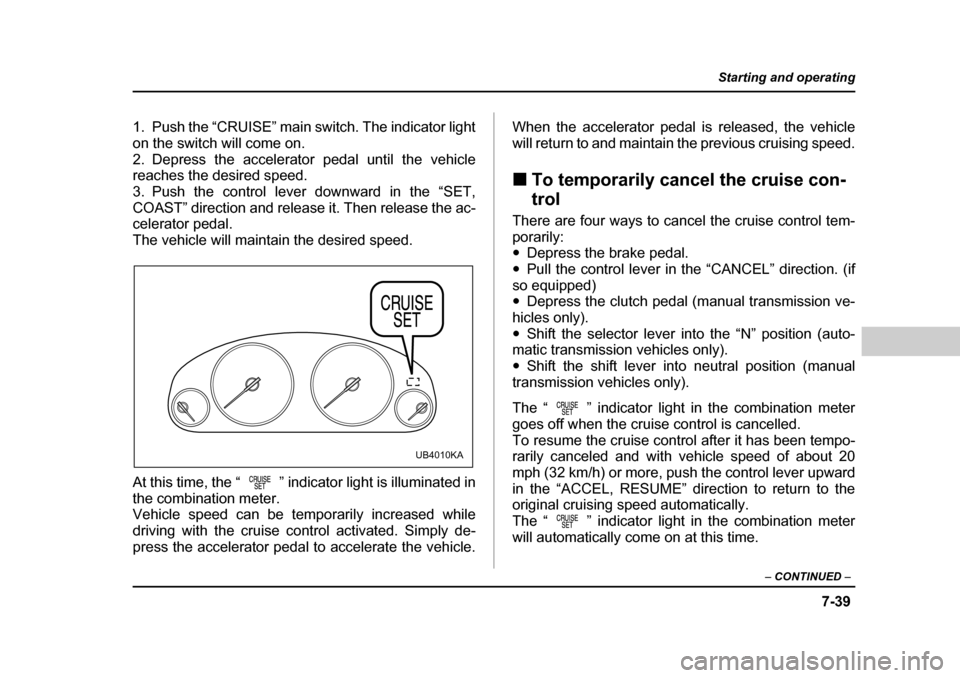
7-39
Starting and operating
– CONTINUED –
1. Push the “CRUISE” main switch. The indicator light
on the switch will come on.
2. Depress the accelerator pedal until the vehicle
reaches the desired speed.
3. Push the control lever downward in the “SET,
COAST” direction and release it. Then release the ac-
celerator pedal.
The vehicle will maintain the desired speed.
At this time, the “ ” indicator light is illuminated in the combination meter.
Vehicle speed can be temporarily increased while
driving with the cruise control activated. Simply de-
press the accelerator pedal to accelerate the vehicle. When the accelerator pedal is released, the vehicle
will return to and maintain the previous cruising speed. �„
To temporarily cancel the cruise con- trol
There are four ways to cancel the cruise control tem-
porarily: �y Depress the brake pedal.
�y Pull the control lever in the “CANCEL” direction. (if
so equipped)�y Depress the clutch pedal (manual transmission ve-
hicles only). �y Shift the selector lever into the “N” position (auto-
matic transmission vehicles only).�y Shift the shift lever into neutral position (manual
transmission vehicles only).
The “ ” indicator light in the combination meter
goes off when the cruise control is cancelled.
To resume the cruise control after it has been tempo-
rarily canceled and with vehicle speed of about 20
mph (32 km/h) or more, push the control lever upward
in the “ACCEL, RESUME” direction to return to the
original cruising speed automatically.
The “ ” indicator light in the combination meter
will automatically come on at this time.
UB4010KA
Page 289 of 469

8-12
Driving tips
starting.
Keep the door locks from freezing by squirting them
with deicer or glycerin.
Forcing a frozen door open may damage or separate
the rubber weather strips around the door. If the door
is frozen, use hot water to melt the ice, and afterwards
thoroughly wipe the water away.
Use a windshield washer fluid that contains an anti-
freeze solution. Do not use engine antifreeze or other
substitutes because they may damage the paint of the
vehicle. �T
Before driving your vehicle
Before entering the vehicle, remove any snow or ice
from your shoes because that could make the pedals
slippery and dangerous.
While warming up the vehicle before driving, check
that the accelerator pedal, brake pedal, and all other
controls operate smoothly.
Clear away ice and snow that has accumulated under
the fenders to avoid making steering difficult. During
severe winter driving, stop when and where it is safe
to do so and check under the fenders periodically. �T
Parking in cold weather
Snow can trap dangerous exhaust gases under
your vehicle. Keep snow clear of the exhaust
pipe and from around your vehicle if you park
the vehicle in snow with the engine running.
Do not use the parking brake when parking for long
periods in cold weather since it could freeze in that po-
sition. Instead, observe the following:
1. Place the shift lever in “1” or “R” for manual trans-
mission vehicles, and in “P” for automatic transmission
vehicles.
2. Use tire stops under the tires to prevent the vehicle
from moving.
When the vehicle is parked in snow or when it snows,
raise the wiper blades off the glass to prevent damage to them.
When the vehicle has been left parked after use on
roads heavily covered with snow, or has been left
parked during a snowstorm, icing may develop on the
brake system, which could cause poor braking action.
Check for snow or ice buildup on the suspension, disc
brakes and brake hoses underneath the vehicle.
Page 293 of 469
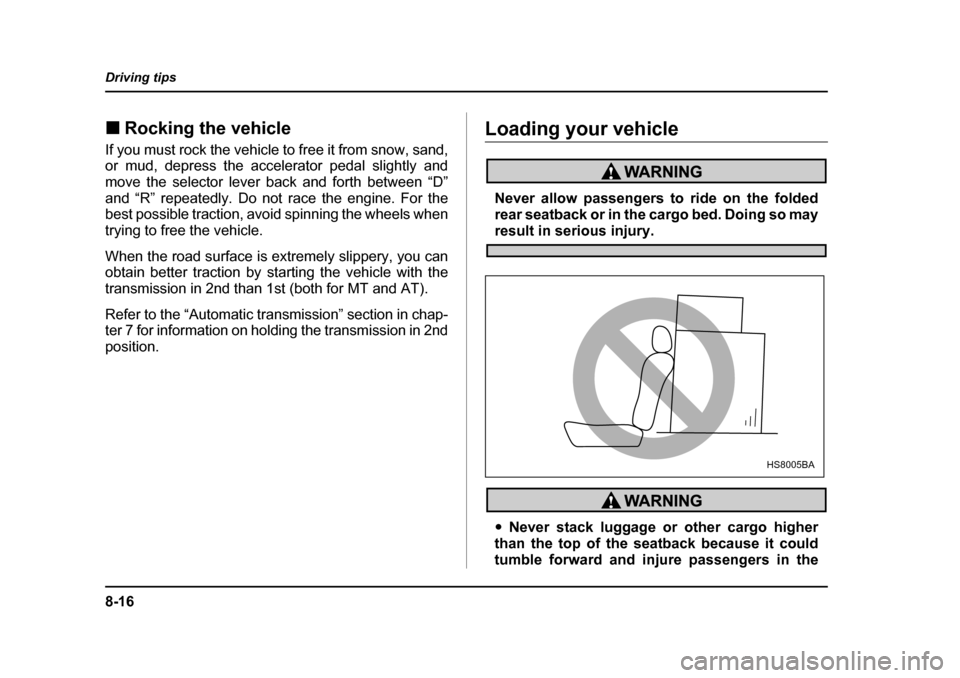
8-16
Driving tips
�„
Rocking the vehicle
If you must rock the vehicle to free it from snow, sand,
or mud, depress the accelerator pedal slightly and
move the selector lever back and forth between “D”
and “R” repeatedly. Do not race the engine. For the
best possible traction, avoid spinning the wheels when
trying to free the vehicle.
When the road surface is extremely slippery, you can
obtain better traction by starting the vehicle with the
transmission in 2nd than 1st (both for MT and AT).
Refer to the “Automatic transmission” section in chap-
ter 7 for information on holding the transmission in 2nd
position.Loading your vehicle
Never allow passengers to ride on the folded
rear seatback or in the cargo bed. Doing so may
result in serious injury.
�y Never stack luggage or other cargo higher
than the top of the seatback because it could
tumble forward and injure passengers in the
HS8005BA
Page 311 of 469

8-34
Driving tips
mal turning radius because the trailer wheels will be
closer than the vehicle wheels to the inside of the turn.
In a tight turn, the trailer could hit your vehicle. �y
Crosswinds will adversely affect the handling of
your vehicle and trailer, causing sway. Crosswinds
can be due to weather conditions or the passing of
large trucks or buses. If swaying occurs, firmly grip the
steering wheel and slow down immediately but gradu-
ally. �y When passing other vehicles, considerable dis-
tance is required because of the added weight and
length caused by attaching the trailer to your vehicle.
1) Left turn
2) Right turn �y
Backing up with a trailer is difficult and takes prac-
tice. When backing up with a trailer, never accelerate
or steer rapidly. When turning back, grip the bottom of
the steering wheel with one hand and turn it to the left
for a left turn, and turn it to the right for a right turn.�y If the ABS warning light illuminates while the vehicle
is in motion, stop towing the trailer and have repairs
performed immediately by the nearest SUBARU deal-er. �T Driving on grades
�y Before going down a steep hill, slow down and shift
into lower gear (if necessary, use 1st gear) in order to
utilize the engine braking effect and prevent overheat-
ing of your vehicle’s brakes. Do not make sudden
downshifts.�y When driving uphill in hot weather, the air condition-
er may turn off automatically to protect the engine from
overheating.�y When driving uphill in hot weather, pay attention to
the water temperature gauge pointer (for all vehicles)
and AT OIL TEMP warning light (for AT vehicles) since
the engine and transmission are relatively prone to
overheating under these conditions. If the water tem-
perature gauge pointer approaches the OVERHEAT
zone or the AT OIL TEMP warning light illuminates,
immediately switch off the air conditioner and stop the
vehicle at the nearest safe place. Refer to the “Engine
1 2
HS8023BB
Page 312 of 469
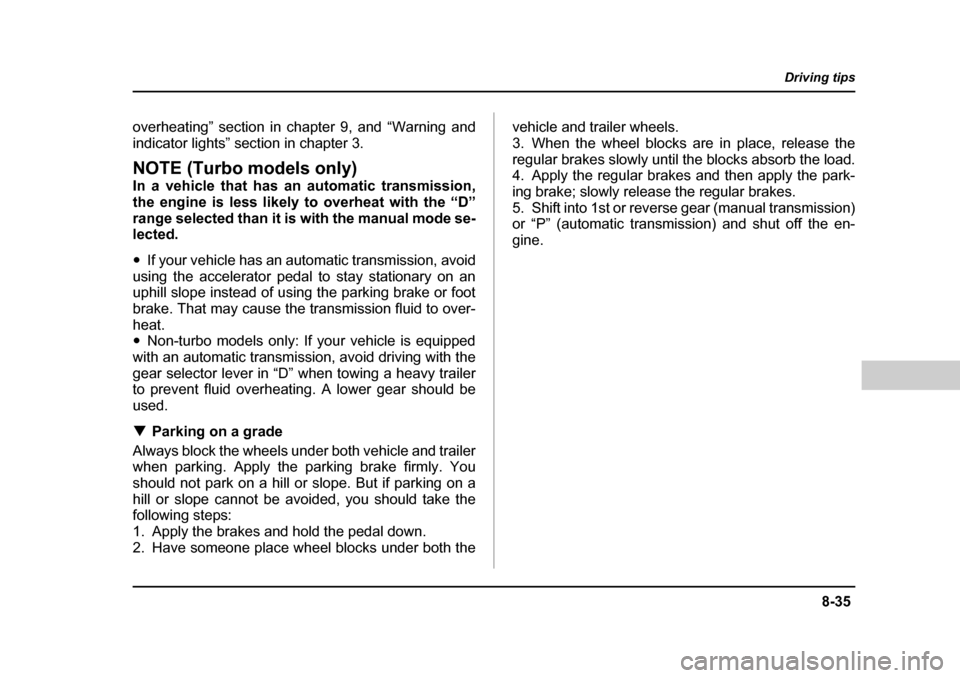
8-35
Driving tips
– CONTINUED –
overheating” section in chapter 9, and “Warning and
indicator lights” section in chapter 3.
NOTE (Turbo models only)
In a vehicle that has an automatic transmission,
the engine is less likely to overheat with the “D”
range selected than it is with the manual mode se-
lected. �yIf your vehicle has an automatic transmission, avoid
using the accelerator pedal to stay stationary on an
uphill slope instead of using the parking brake or foot
brake. That may cause the transmission fluid to over-
heat. �y Non-turbo models only: If your vehicle is equipped
with an automatic transmission, avoid driving with the
gear selector lever in “D” when towing a heavy trailer
to prevent fluid overheating. A lower gear should be
used. �T Parking on a grade
Always block the wheels under both vehicle and trailer
when parking. Apply the parking brake firmly. You
should not park on a hill or slope. But if parking on a
hill or slope cannot be avoided, you should take the
following steps:
1. Apply the brakes and hold the pedal down.
2. Have someone place wheel blocks under both the vehicle and trailer wheels.
3. When the wheel blocks are in place, release the
regular brakes slowly until the blocks absorb the load.
4. Apply the regular brakes and then apply the park-
ing brake; slowly release the regular brakes.
5. Shift into 1st or reverse gear (manual transmission)
or “P” (automatic transmission) and shut off the en-
gine.
Page 324 of 469
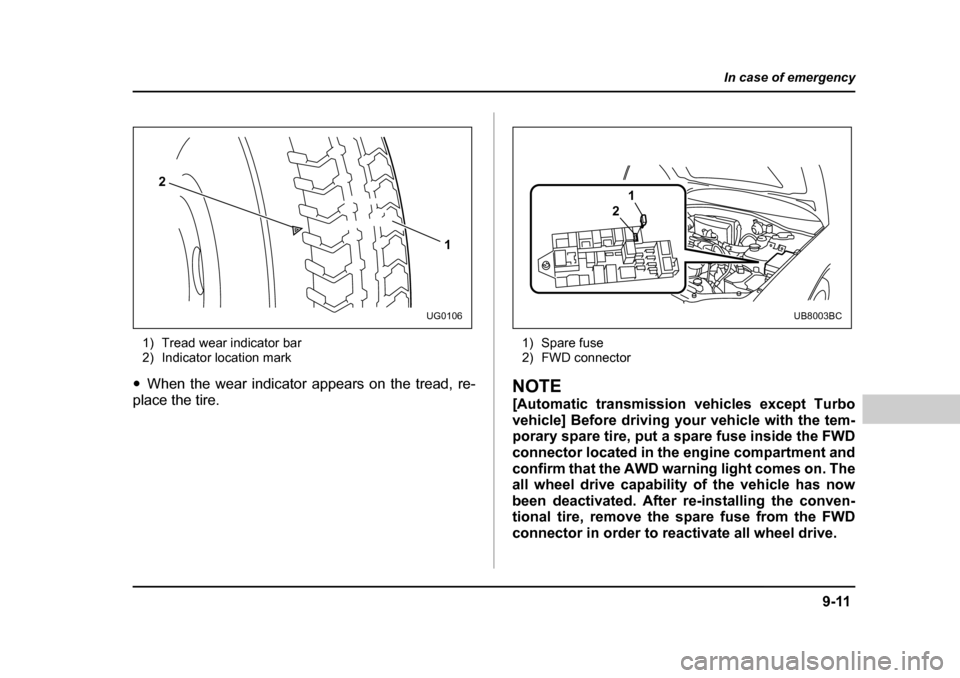
9-11
In case of emergency
– CONTINUED –
1) Tread wear indicator bar
2) Indicator location mark
�y When the wear indicator appears on the tread, re-
place the tire. 1) Spare fuse
2) FWD connector
NOTE
[Automatic transmission vehicles except Turbo
vehicle] Before driving your vehicle with the tem-
porary spare tire, put a spare fuse inside the FWD
connector located in the engine compartment and
confirm that the AWD warning light comes on. The
all wheel drive capability of the vehicle has now
been deactivated. After re-installing the conven-
tional tire, remove the spare fuse from the FWD
connector in order to reactivate all wheel drive.
1
2
UG0106
1
2
UB8003BC
Page 325 of 469
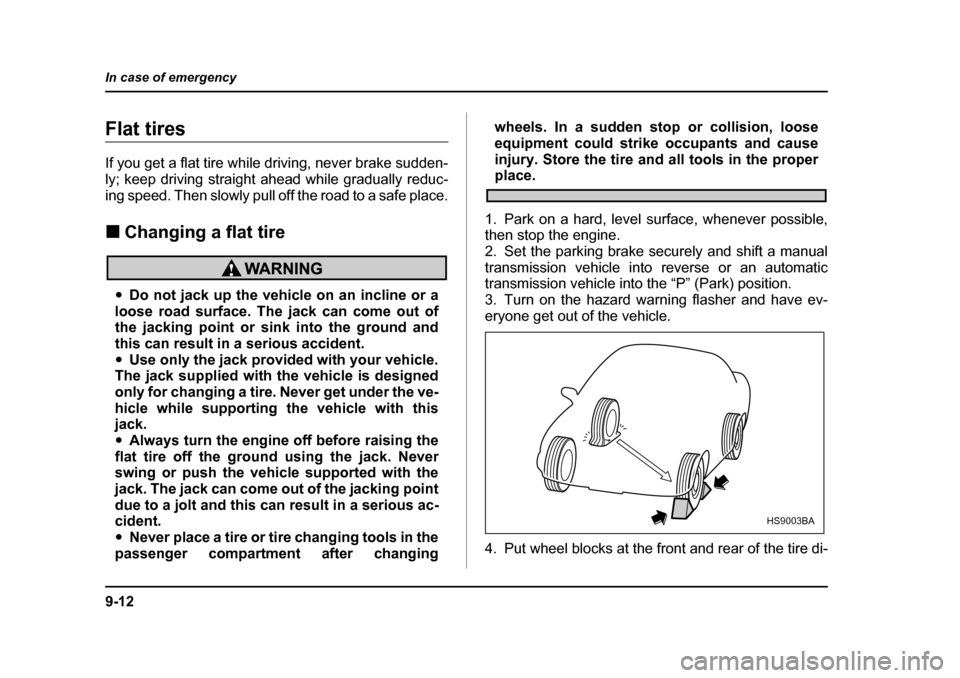
9-12
In case of emergency
Flat tires
If you get a flat tire while driving, never brake sudden-
ly; keep driving straight ahead while gradually reduc-
ing speed. Then slowly pull off the road to a safe place. �„
Changing a flat tire
�yDo not jack up the vehicle on an incline or a
loose road surface. The jack can come out of
the jacking point or sink into the ground and
this can result in a serious accident. �y Use only the jack provided with your vehicle.
The jack supplied with the vehicle is designed
only for changing a tire. Never get under the ve-
hicle while supporting the vehicle with thisjack. �y Always turn the engine off before raising the
flat tire off the ground using the jack. Never
swing or push the vehicle supported with the
jack. The jack can come out of the jacking point
due to a jolt and this can result in a serious ac-
cident. �y Never place a tire or tire changing tools in the
passenger compartment after changing wheels. In a sudden stop or collision, loose
equipment could strike occupants and cause
injury. Store the tire and all tools in the proper
place.
1. Park on a hard, level surface, whenever possible,
then stop the engine.
2. Set the parking brake securely and shift a manual
transmission vehicle into reverse or an automatic
transmission vehicle into the “P” (Park) position.
3. Turn on the hazard warning flasher and have ev-
eryone get out of the vehicle.
4. Put wheel blocks at the front and rear of the tire di-
HS9003BA
Page 341 of 469
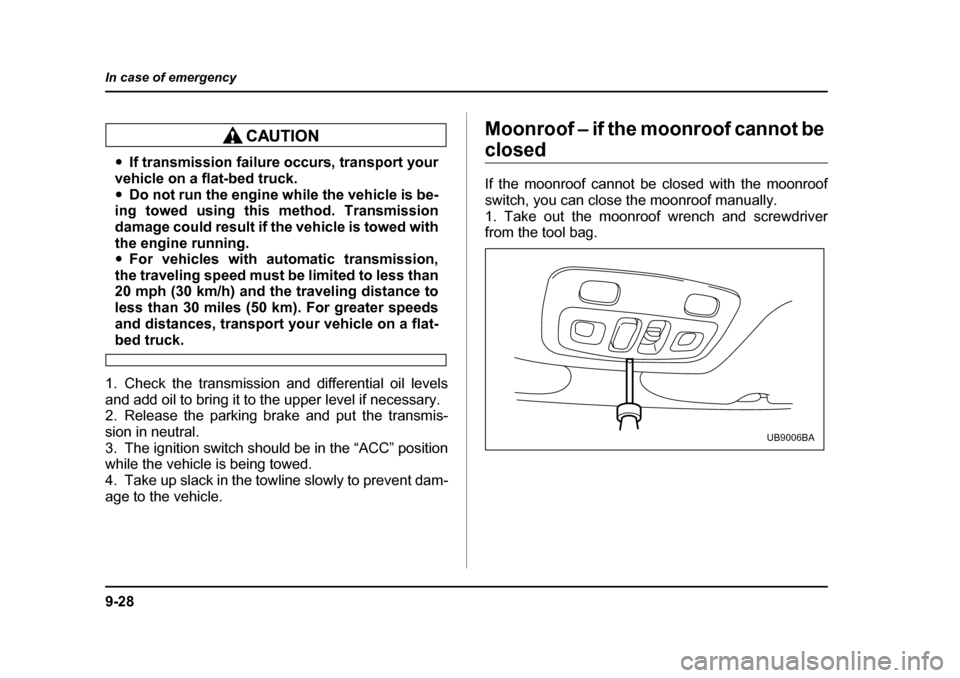
9-28
In case of emergency
�y
If transmission failure occurs, transport your
vehicle on a flat-bed truck. �y Do not run the engine while the vehicle is be-
ing towed using this method. Transmission
damage could result if the vehicle is towed with
the engine running. �y For vehicles with automatic transmission,
the traveling speed must be limited to less than
20 mph (30 km/h) and the traveling distance to
less than 30 miles (50 km). For greater speeds
and distances, transport your vehicle on a flat-
bed truck.
1. Check the transmission and differential oil levels
and add oil to bring it to the upper level if necessary.
2. Release the parking brake and put the transmis-
sion in neutral.
3. The ignition switch should be in the “ACC” position
while the vehicle is being towed.
4. Take up slack in the towline slowly to prevent dam-
age to the vehicle. Moonroof – if the moonroof cannot be
closed
If the moonroof cannot be closed with the moonroof
switch, you can close the moonroof manually.
1. Take out the moonroof wrench and screwdriver
from the tool bag.
UB9006BA